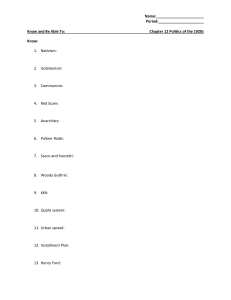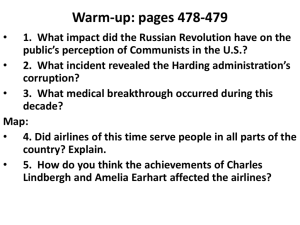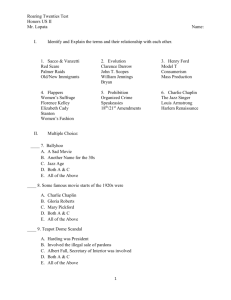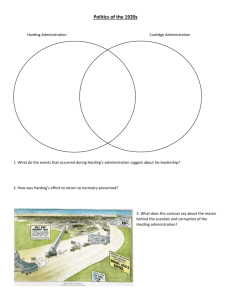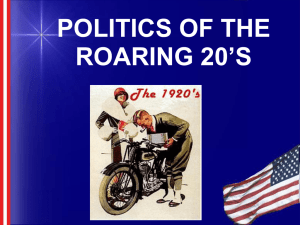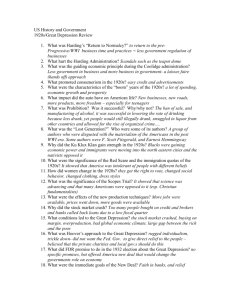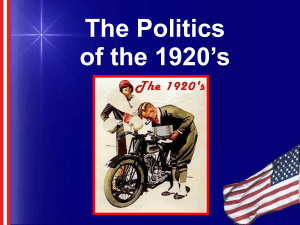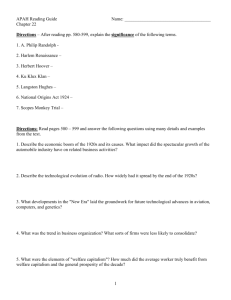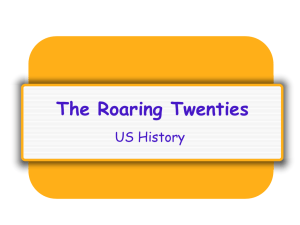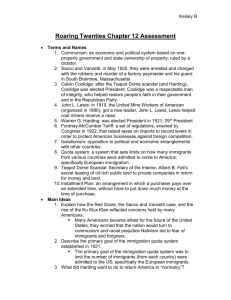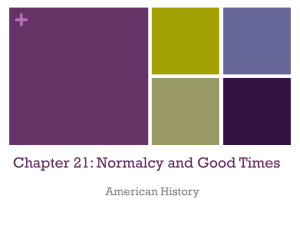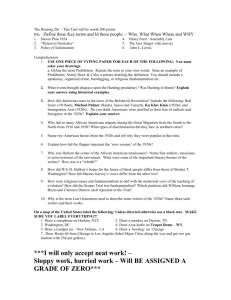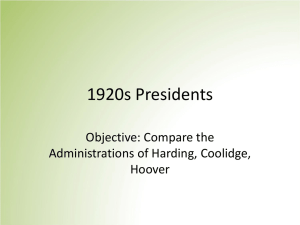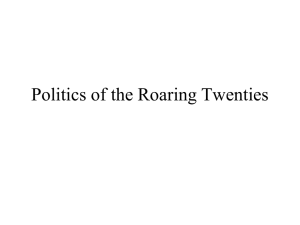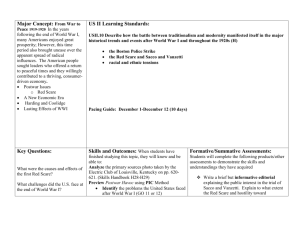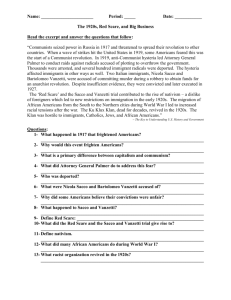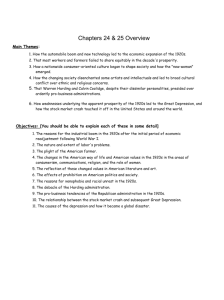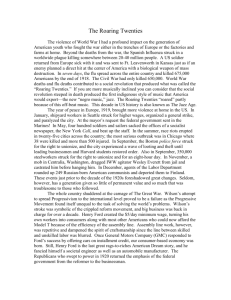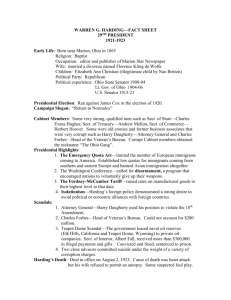File
advertisement
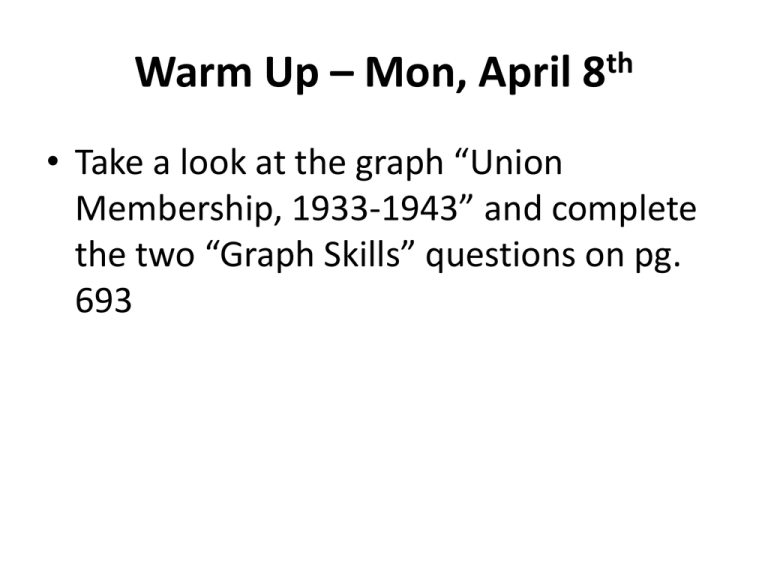
Warm Up – Mon, April 8th • Take a look at the graph “Union Membership, 1933-1943” and complete the two “Graph Skills” questions on pg. 693 1. Describe the political philosophies and agendas of Presidents Harding and Coolidge. Harding Coolidge • Normalcy – return to • Prosperity rested on normal (after WWI) business leadership • Relaxed, easygoing • Government should interfere as little as • Riddled with possible corruption • Restore integrity to – The Ohio Gang the White House – The Teapot Dome Scandal 2. What examples of political corruption were present in the Harding administration? • The Ohio Gang – Harding appointed many of his friends from Ohio to government positions • Forbes Scandal – Ohio Gang member Charles Forbes, head of Veterans Bureau, sold scare medicines from veterans’ hospitals • Teapot Dome Scandal – Albert Fall, secretary of the interior, received bribes for secretly leasing US lands with oil to private companies 3. Describe how the rise of the automobile changed American social and economic life in the 1920s. • Allowed people to live farther from their work, increased suburban living • People could move more easily • Rural life not so isolated • Changed socializing and dating • Created new small businesses (gas stations, garages) 4. What did the Sacco and Vanzetti trial, the Quota Acts, and the reemergence of the Ku Klux Klan show about American attitudes toward immigrants in the 1920s? • The fear and prejudice many felt toward Germans and Communists expanded to include all immigrants. This triggered a general rise in racism and NATIVISM. 5. What factors were responsible for the economic boom of the 1920s? Government •Minimal interference with businesses •Cut government spending and debt •Eliminated or reduced taxes •High tariffs Business •Mass production reduced prices •Technology such as autos, airplanes, and radios led to new industries •New consumer goods fueled manufacturing boom Consumers •More disposable income •More leisure time •Easily available credit •Mass advertising 6. What did people do for entertainment in the 1920s? • Sports – Baseball, Boxing, and College Football • Movies – Motion Pictures, silent films with music and subtitles • Radio Shows and Music – Jazz, news programs, comedy, and drama 7. How did attitudes about gender and sexuality change in the 1920s? • Importance of romance, pleasure, and friendship linked to successful marriages • More women in the workforce • More women attending college • Flapper – young, dramatic, and stylish woman – Smoked, drank, and dress too revealing 8. What was the Red Scare? How did government officials respond the threat of communism? • Red Scare – the fear that Communists, or “reds,” might seize power led to a nationwide panic • The Palmer Raids – a series of raids on the headquarters of various “radical” organizations; detained thousands and deported nearly 600 9. Explain why the Scopes Trial reflected the influence of religious fundamentalism. • Clash between evolutionists and creationists • 1925 Tennessee, Butler Act, outlawed any teaching of evolution • Teacher, John Scopes, arrested for teaching evolution • Convicted, later overturned • Show strength of fundamentalists but also change in culture 10. What factors encouraged the passage of the 18th amendment? • Long-time temperance movement • Religious fundamentalists • Believed banning alcohol would help to eliminate domestic violence, unemployment, and divorce 11. What factors led to the Great Depression? Stock Market •Many investors bough stock on margin •Sharp drop in market prices left investors in debt •Bank runs closed banks and left many in debt Underlying Causes •Overproduction and low interest rates •Uneven distribution of income, which led to low demand •Depressed farm sector •Weak international market with high tariffs 12. How did Herbert Hoover and Franklin D. Roosevelt differ in their responses to the Great Depression? Hoover FDR • Believed market would recover quickly on its own • Aid should come from local charities and state governments • Aid from Federal Government would cause American’s to loose their “Rugged Individualism” • Massive government spending to stimulate economy (deficit spending) • Federal aid to consumers and businesses • Public works giving jobs to unemployed • Reform of banking and stock market 13. Explain Franklin D. Roosevelt’s attempt to “pack” the federal court system, the public’s reaction, and its results. • Supreme Court found several New Deal actions unconstitutional • FDR proposed law that would allow him to appoint up to six new justices that would support his New Deal • Public feared president would have too much power • Law failed but scared Supreme Court 14. Was the New Deal an effective response to the problems of the Great Depression? • The New Deal provided many necessary reforms to the banking and stock market systems • While it gave relief to some people it alone did not bring the country out of the Great Depression
